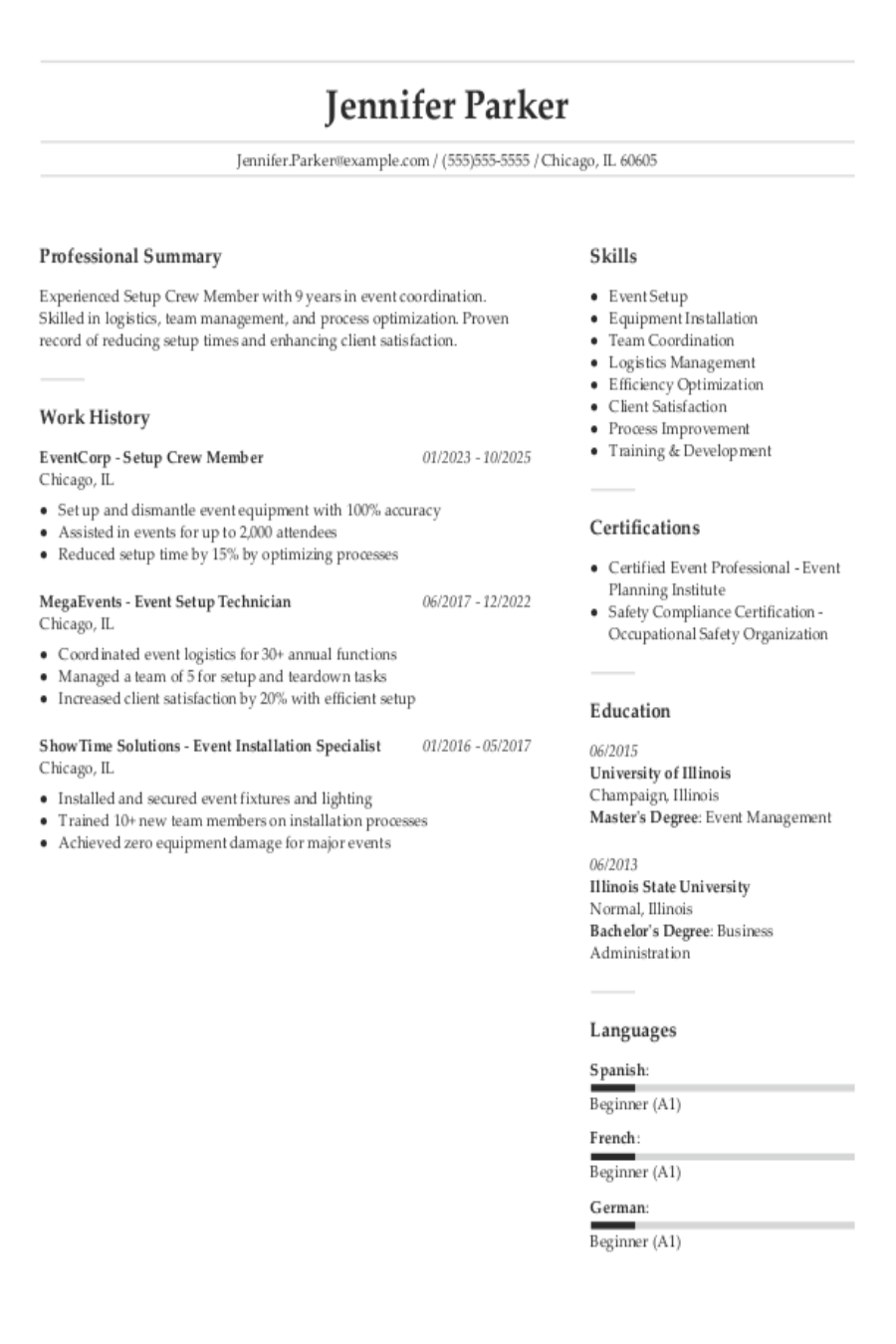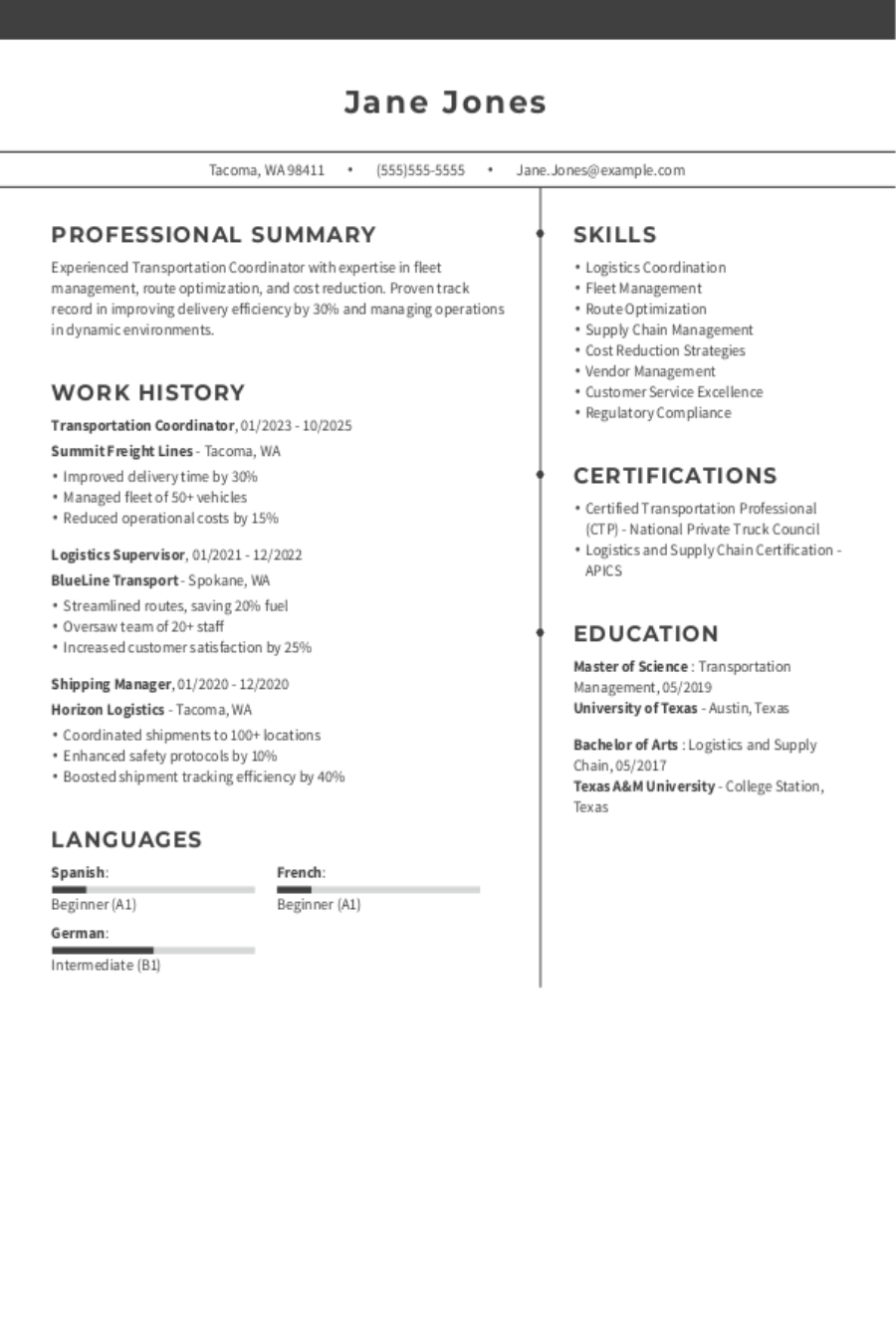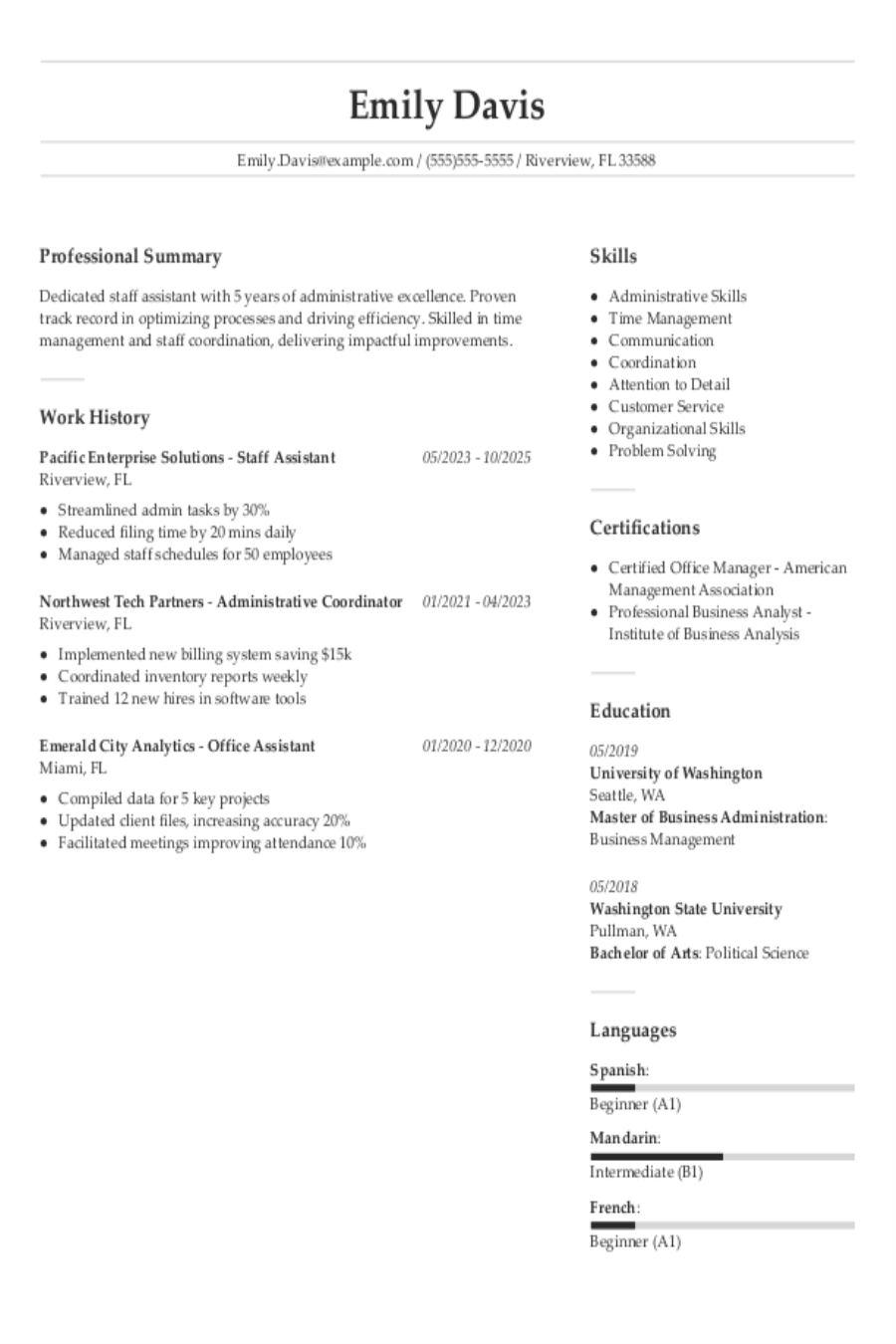Popular Hair Stylist Resume Examples
Entry-level hair stylist resume
An entry-level resume for a hair stylist should focus on showcasing relevant training, certifications, creativity, customer service skills, and any hands-on experience to attract potential employers.
Showcases education: The applicant effectively highlights creative capabilities and technical training by placing the candidate's education near the top of the document.
Focuses on goals: The job seeker demonstrates a dedication to professional growth through advanced education in hair design and practical experience, showcasing their ability to improve client experiences and drive salon success.
Mid-career hair stylist resume
A mid-career hair stylist resume should emphasize a combination of hands-on experience, creative skills, and ongoing professional development to attract potential clients and employers alike.
Employs active language: Dynamic action verbs like "increased," "managed," and "advised" demonstrate a proactive approach, highlighting measurable results in client retention and sales growth.
Includes mix of skills: This resume illustrates a strong balance between technical skills in hairstyling and essential interpersonal abilities, showcasing the applicant's skill in both service delivery and client relationship management.
Experienced hair stylist resume
An experienced hair stylist resume should highlight key skills, client success stories, and professional development to clearly demonstrate growth and expertise in the industry.
Highlights experience: This resume's summary effectively showcases the job seeker's extensive experience in hair styling, highlighting key achievements such as client retention and sales growth.
Quantifies achievements: Quantifiable achievements, such as increasing client retention by 25% and achieving 30% annual sales growth, clearly illustrate a job seeker's impact. These metrics provide concrete evidence of success that resonates with recruiters, making accomplishments more relatable and compelling.
No experience hair stylist resume
A resume for an applicant with no experience should highlight relevant skills, training, and any hands-on practice or volunteer work to showcase the job seeker's potential and passion for the industry.
Favors clarity over complexity: The resume's streamlined design emphasizes relevant experience and education, allowing the applicant's skills in hair styling and client engagement to shine through without distractions.
Overcomes lack of work history: Emphasizing skills in hair cutting, coloring techniques, and client consultation demonstrates the job seeker's readiness to excel as a hair stylist, despite limited formal experience.
Hair Stylist Resume Template
Looking to showcase your skills? Start with this stylish hair stylist resume template—simply personalize it with your details and watch your career flourish.
Tao Davis
Milwaukee, WI 53210
(555)555-5555
Tao.Davis@example.com
Professional Summary
Dynamic hair stylist with a proven track record in trend-setting styles, client-focused solutions, and revenue optimization strategies within upscale salons.
Work History
Hair Stylist
Elegant Creations Salon - Milwaukee, WI
January 2025 - September 2025
- Increased client base by 20%
- Generated $15k monthly revenue
- Trained 3 junior stylists
Senior Hair Consultant
Prestige Hair Studio - Milwaukee, WI
January 2023 - December 2024
- Improved styling efficiency by 15%
- Coordinated salon events
- Designed 5 new hair treatments
Junior Hair Specialist
Luxe Salon & Spa - Brookfield, WI
January 2021 - December 2022
- Styled over 200 clients monthly
- Reduced product waste by 10%
- Conducted client consultations
Skills
- Precision Cutting
- Color Theory
- Client Consultation
- Scalp Treatments
- Trend Analysis
- Product Knowledge
- Salon Management
- Hair Extensions
Education
Master Cosmetology
Florida Institute of Beauty Miami, Florida
December 2020
Bachelor Hair Styling
Miami Beauty Academy Miami, Florida
December 2017
Certifications
- Certified Hair Color Technician - National Beauty Certification Agency
- Advanced Styling Techniques - Cosmetology Excellence Institute
Languages
- Spanish - Beginner (A1)
- French - Intermediate (B1)
- Italian - Intermediate (B1)
Writing Your Hair Stylist Resume
Having explored inspiring resume examples, you are now prepared to dive into the process of how to write a resume. We will guide you through each section in detail, ensuring you have all the tools necessary for success.
List your most relevant skills
A powerful skills section on your hair stylist resume should focus on both technical abilities, such as cutting, coloring, and styling techniques, and essential soft skills like customer service and creativity. By emphasizing these areas, you can effectively demonstrate your readiness to meet the demands of the role.
To maximize your chances with recruiters and applicant tracking systems (ATS), incorporate keywords from the job listing directly into your skills section. This strategy helps ensure that both human readers recognize your fit for the position and ATS algorithms identify you as a qualified job seeker.
Example of skills on a hair stylist resume
- Proficient in cutting, coloring, and styling hair to meet client needs
- Experienced in using a range of hairstyling tools and products
- Strong communicator with excellent customer service skills
- Creative thinker capable of delivering innovative hairstyles
The skills section of your resume is important for demonstrating your readiness for the hair stylist position. It should incorporate both the technical skills specified in the job description, such as cutting and coloring techniques, alongside essential soft skills like communication and creativity. This balance shows potential employers that you are well-equipped to meet their expectations.
Highlight your work history
Your work experience section must highlight not only your job duties but also your key achievements. Focus on showcasing how you’ve applied your skills to deliver exceptional results for clients, and incorporate relevant industry keywords that will catch the eye of hiring managers.
For each job entry, include essential details such as your title, the name of the salon or employer, and the dates you worked there. This information helps establish professional credibility and provides employers with a clear timeline of your experience. Emphasize any notable accomplishments, like increasing client retention rates or successfully managing special events.
Example of a hair stylist work experience entry
- Hair Stylist
Salon Luxe - Los Angeles, CA
June 2019 - Present - Create customized hairstyles for over 50 clients weekly, improving their satisfaction and building a loyal customer base
- Use advanced cutting techniques and color applications to achieve desired looks, resulting in a 30% increase in client referrals
- Maintain a clean and organized workspace while ensuring compliance with health and safety regulations to provide a safe environment for clients
- Train junior stylists on new trends and best practices, fostering professional development within the team and improving service quality by 25%
- Implement effective sales strategies for retail products, contributing to a significant boost in overall salon revenue by 15%
Highlighting outcomes and achievements in your experience section is essential for standing out to potential employers. By showcasing how your work has positively impacted clients or contributed to salon success, you not only demonstrate your skills, but also convey your value as a hair stylist. This results-driven approach makes a stronger impression than simply listing daily responsibilities.
Include your education
The education section of your hair stylist resume should clearly present your training and qualifications in reverse-chronological order. Begin with your most recent certification or diploma from a cosmetology school and include any additional relevant certifications you may hold. If you have obtained advanced education such as a degree, feel free to omit your high school diploma.
For those currently enrolled in beauty programs or pursuing additional training, it is important to indicate your highest completed level of education along with an expected graduation date. You can also highlight specific coursework that pertains to hair styling techniques or customer service skills.
Common certifications for a hair stylist resume
- Cosmetology License – State Board of Cosmetology
- Certified Haircolorist (CHC) – American Board of Certified Haircolorists
- Master Stylist Certification – National Cosmetology Association (NCA)
- Hair Extensions Certification – International Hair Extensions Exchange (IHEE)
Sum up your resume with an introduction
Creating an effective profile section on your paralegal resume is essential for making a positive first impression. This section acts as a snapshot of your qualifications, allowing hiring managers to quickly gauge your fit for the role.
If you're an experienced job seeker, consider using a professional summary to showcase your accomplishments. This format allows you to emphasize significant milestones in your career, demonstrating how you've contributed to previous employers' success. If you’re new to the workforce, write a resume objective that summarizes your goals and growing experience.
Professional summary example
Passionate hair stylist with over 8 years of experience in diverse salon settings. Recognized for delivering exceptional customer service and creating stunning hairstyles tailored to individual client preferences. Expert in color techniques, precision cutting, and trend-based styling, consistently exceeding client expectations and fostering loyalty through personalized consultations.
Resume objective example
Enthusiastic hair stylist eager to use creative flair and strong communication skills to improve the client experience at a trendy salon. Committed to delivering exceptional styling services and building lasting relationships through attentive customer care and trend awareness.
In your resume profile, begin with your job title as a hair stylist. This approach allows you to immediately convey your professional identity and helps employers quickly understand who you are and what skills you bring to the table.
Add unique sections to set you apart
Improve your resume by including optional sections that highlight your unique qualifications as a hair stylist. These sections allow you to present skills and experiences that set you apart from other applicants.
By incorporating relevant hobbies or showcasing volunteer work, you give employers insight into your personality and values. Perhaps you’ve organized community events or participated in beauty workshops. Such activities not only demonstrate your passion for the industry but also reflect your commitment to continuous improvement and teamwork, making you a well-rounded applicant.
Three sections perfect for a hair stylist resume
- Languages: As a hair stylist, you interact closely with clients. If you know multiple languages, highlighting your language skills on your resume can improve client relationships and expand your clientele.
- Volunteer Work: Including volunteer work on a resume highlights your dedication to community service and hones skills like teamwork and adaptability, making you more attractive to potential employers.
- Accomplishments: As a hair stylist, quantifiable accomplishments are essential for demonstrating your expertise and client satisfaction. You can either weave these accomplishments into your work experience or list them in their own achievements section.
5 Resume Formatting Tips
- Choose a format that matches your career stage.
Choosing the right resume format is important for showcasing your skills. If you're an experienced hair stylist, opt for a chronological resume to highlight your work history. For those just starting out, a functional resume can emphasize your training and skills instead. Consider a combination format if you have both experience and unique qualifications to present.
- Pick a smart resume template.
Using a resume template is key to ensuring your information stands out. A well-structured design improves readability and helps hiring managers quickly understand your qualifications. Select an ATS-friendly font while maintaining a clean layout to leave a lasting impression.
- Select an appropriate font.
Opt for a clear, professional resume font style that improves readability. Fonts like Helvetica, Georgia, or Verdana are excellent choices because they help your resume stand out to both recruiters and applicant tracking systems.
- Use consistent formatting.
Align your resume to the left and maintain uniform margins. This ensures a polished, professional look that captures attention right away.
- Keep your resume to one or two pages.
When crafting your resume, remember that resumes should be one page long unless you have extensive experience. Focus on keeping your content concise and relevant to highlight your skills effectively.
Tools for Your Job Search
Are you excited to apply for that hair stylist position you've been dreaming about? Before you hit send on your application, consider using our ATS Resume Checker. This tool provides essential feedback on how your resume interacts with the automated systems many salons use for initial applicant screening.
Need further assistance in creating a standout resume? Our AI Resume Builder offers personalized recommendations tailored specifically to your experience in the beauty industry, along with stylish templates that highlight your skills and artistic flair effectively.
Frequently Asked Questions
Last Updated: October 3, 2025
Absolutely. A cover letter is important as it adds depth to your resume and provides a personal touch that fosters communication with employers. It allows you to convey your passion for the hairstyling role and demonstrate how your skills and experiences make you an ideal fit. So, take a moment to write a cover letter that showcases your unique talents.
For a quick and efficient solution, consider using our AI Cover Letter Generator. It helps you create tailored cover letters in minutes, with various cover letter template options available that perfectly align with your resume, ensuring a polished and professional application package.
Resumes are concise documents usually spanning one to two pages, highlighting your most relevant work experiences and skills. In contrast, CVs offer a detailed overview that can extend several pages, covering academic achievements, publications, research contributions, and extensive professional history.
You should consider using a CV when applying for positions in academia or specialized fields like law and medicine. For crafting a tailored CV quickly and efficiently, our online CV Maker service is an excellent resource. With various CV templates designed for different industries and career levels, it helps you create a standout CV effortlessly.
A hair stylist resume should ideally be one page long, showcasing your skills and experience clearly. However, if you have extensive experience or a diverse portfolio, consider using a two-page resume to effectively highlight your qualifications and unique talents.
To improve your hair stylist resume, focus on tailoring it to highlight the essential skills for each position you apply for. Review job listings closely to pinpoint specific keywords and phrases. Incorporate these into your resume to effectively showcase how your qualifications align with the desired role.
When applying for hair stylist positions, briefly mention your career goals in your resume summary. For a deeper connection, elaborate on these aspirations in your cover letter. Focus on seeking roles that not only align with your skills but also offer opportunities for growth and advancement in the beauty industry.
Was this information helpful? Let us know!
Leisha is a career industry editor dedicated to helping job seekers excel in their careers.
More resources

The AI Boss Effect: 97% of Workers Have Asked ChatGPT for Advice Instead of Their Manager
Resume Now s latest report explores how AI is replacing manage...

37 Unique Skills to Put on Your Resume
Trying to avoid the skills you see pop up on resumes repeatedl...

Resume Now Spotlights 14 High-Innovation, High-Growth Jobs That Pay $60K+
Resume Now s latest report highlights some of the highest payi...

Event Setup Resume: Examples, Templates & Tips for 2025
Excited about diving into a dynamic new position in event setu...



